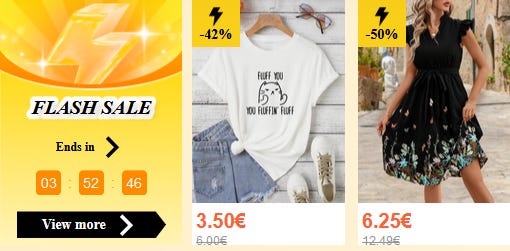🏷️ Categories: Software, Decision making and biases, Behavior
I was chatting with a friend in the park and he told me something that surprised him.
—Can you believe that yesterday a link to a Tiktok video was sent to me by Whatsapp, I went in to watch it and in the end I was stuck in there for half an hour? How well done that is! His intention was to watch a short video and then go on with his stuff, but he was caught for 30 minutes. He's one of those people who hardly ever uses social media.
It left me thoughtful, they had caught the person who was the hardest to catch.
That got me thinking about the psychology behind the most popular apps, looking at what mechanisms they use to maximize their usage and revenue.
Infinite scroll
We all used to click around the internet, now we scroll.
Apps are not designed by dumb people. When you use any social network, you have to swipe down to bring up new content. The content generation is literally infinite and the more you use the app, the more data it collects about your preferences and the more palatable content you'll get.
It's an endless loop where there's always something new to see.
Scrolling is so satisfying because it exploits an elementary psychological mechanism. The brain has evolved to understand the environment to predict what will happen next. By recognizing patterns we can see cause and … relationships.
You were expecting the word “effect,” weren't you?
Your brain recognizes patterns (Eyal, 2012).
Scrolling always offers new content, so there are no predictable patterns and that generates a lot of curiosity to keep scrolling and see what will happen next. This is known in psychology as “intermittent reinforcement”, that is, you don't know when the next dose of gratification will be, but you just have to keep scrolling.
Psychologists have long studied this behavior with pigeons.
We tend to believe that our behavior is due to sophisticated causes. In reality, the experimental psychologist's best friends are rats, dogs and pigeons, with them we discover behavioral laws applicable to humans.

They could have the content update automatically, like they used to do on Instagram, or by pressing a button, but it's done by dragging your finger down because it's more pleasurable than just watching it reload on its own.
It gives a sense of control, that we're the ones who are discovering things.
The power of convenience
No one intentionally says, I'm going to watch Tiktok for 15 minutes! (Or Twitter, Instagram...).
Most of the time you just walk in out of boredom, watch something and it always sucks you in longer than initially intended.
There are many experiments, for example. People are 21% more likely to watch more related videos just by putting a section called “Related” next to it (Woolley et al., 2022). It is very convenient to jump from video to video because there is no response cost, and the more you do it, the better the algorithm recommends.
This is why there is no longer any social network that does not have such an algorithm in which to discover things just like the ones you previously searched for.
Who would refuse to eat from the plate that your butler brought with everything you like?
Principle of scarcity
Online shopping sites exploit this psychological technique to perfection.
We value something more when it is scarce just because it is scarce. Those who work in marketing know this. The first thing I saw as I entered Shein, Amazon and Ali Express were 3 ways to apply the scarcity principle:
1. Flash sales
Many sites have a section of products whose offers have a very limited time. All the products in that category have discounts that expire in a few hours and have a real time counter of the remaining time of the offer.
This generates a sense of urgency (FOMO) in the user.

The idea is simple, to encourage irrational and impulsive buying, otherwise you wouldn't buy it.
2. “Few units left”.
You see a product that interests you and you notice that it says “few units left”. If you had doubts about whether to buy it or not, you no longer have any, this phrase again seeks to create a sense of urgency. “I must hurry, it will soon be sold out.”
As if there weren't thousands of similar products and thousands of pages with that product…
3. Percentage claimed
I only found this technique to take advantage of the scarcity principle on Amazon.
It is a more sophisticated version of the “few units left” phrase. In this case, a bar appears with the remaining percentage of the product to encourage your purchase.

On the same Amazon product we can see:
1 discount number in a red box.
1 scarcity principle using a time-limited deal warning
1 scarcity principle using the percentage bar.
1 discount if you have vourcher.
There are more claims than text on the product.
Impressive.
Principle of social proof
We imitate the behavior of others, especially if we don't know what to do.
All websites have their rating section with scores. If you have doubts about a product, it is not uncommon to go to the reviews and based on the opinions decide whether to buy or not, and of course there is marketing of reviews to inflate products.
In many cases, it also tells you which products have sold a lot and the great reviews they have. “1,3k+ sold”, “10k+ sold”, “(500+) reviews…”

They might omit the information about how much has been sold, but there is a reason it is there and now you know it.
What to do now
As you can see, human behavior is influenceable and they have managed to create an ideal environment to make us fall into the Diderot Effect.
Marketing, and in general any application we use, takes advantage of these psychological techniques to increase its revenue in one way or another. I have shown you here just a few of the many techniques that are resorted to everywhere.
The best way to avoid these influences is to know them to form a solid criterion and realize when they are trying to influence you.
Here are the 6 basic laws of persuasion that you should know so you don't fall for them.
✍️ It's your turn: Were you aware of the claims that are constantly being thrown at us?
💭 Quote of the day: “I think they should include shopping as physical exercise. My heart never races as much as it does when I see a “50% off” sign.” Confessions of a Shopaholic, Sophie Kinsella.
References 📚
Eyal, N. (2012, 29 August). Infinite Scroll: The Web’s Slot Machine. Psychology Today. https://www.psychologytoday.com/us/blog/automatic-you/201208/infinite-scroll-the-webs-slot-machine
Woolley, K., & Sharif, M. A. (2022). Down a Rabbit Hole: How Prior Media Consumption Shapes Subsequent Media Consumption. Journal Of Marketing Research, 59(3), 453-471. https://doi.org/10.1177/00222437211055403






Great read! Glad I scrolled through it. 😁 So true how much marketing is based on psychology. I often enjoy seeing the different techniques that are used and how effective they can be. While it doesn't usually win me over anymore, I appreciate good marketing.
Recently I posted a blurb on my FB feed referring to my three books for sale on Amazon. All three were kindle format and Amazon lowered the price to $0. So, I wrote: "Get your copies while they last." The joke? They're digital downloads to a kindle. They'll always be there unless Amazon actually erases poorly selling books.